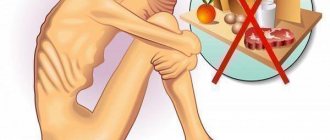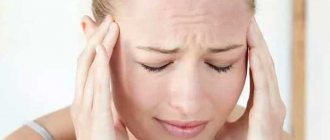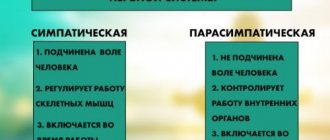Spasm is an involuntary contraction (twitch) of a muscle or group of muscles, usually accompanied by severe pain. There are spasms of striated (skeletal) muscles (for example, with some paralysis) and smooth muscles - the vascular wall (for example, with angina pectoris), bronchi, esophagus (cardiospasm), intestines, etc. Spasms of skeletal muscles make movement difficult.
Smooth muscle spasms disrupt various organ functions. A series of spasms or constant spasms are called spasms. According to the mechanism, spasms are distinguished: Epileptic and non-epileptic. Epileptic seizures are caused by the simultaneous discharge of a large population of neurons (hypersynchronous discharge) and serve as a manifestation of various types of convulsive epileptic seizures.
Nonepileptics are diverse in pathogenesis. They may be associated with: a nonspecific increase in the excitability of segmental (repercussive convulsions) and suprasegmental (reflex convulsions) structures of the central nervous system, neuronal dysfunction due to anoxia (convulsions during strangulation), and anoxyischemia (convulsive form of fainting, etc.), activation of some brain structures under the influence of poison or toxin (toxic convulsions) dysfunction of neurons under the influence of endocrine, electrolyte and metabolic disorders (for example, tetanic convulsions, convulsions due to vitamin B6 deficiency, hypoglycemia) disorder of mechanisms involved in the organization of sleep (gaze convulsions in postencephalic parkinsonism) .
As well as a violation of suprasegmental influences on the segmental apparatus under the influence of psychogenic factors (hysterical convulsions) or organic brain lesions (hormetonic convulsions), local neurogenic disorders, for example local muscle cramps.
Spasms are also divided into: Tonic spasms - prolonged muscle tension. Clonic spasms are synchronous jerky muscle contractions alternating with relaxation.
To designate tonic spasms of certain muscle groups, special terms are used: “trismus” - a spasm of the masticatory muscles, “blepharospasm” - a spasm of the orbicularis oculi muscles. Clonic generalized seizures are sometimes called convulsions. Along with spasms of striated muscles, spasms of smooth muscles are also known: cardiospasm, pylorospasm.
Spasms in children occur especially easily at an early age (which is due to the peculiarities of brain development) under the influence of infections, intoxications and injuries, psychogenic factors, etc.
Treatment is based on correction of the underlying disease in combination with anticonvulsants (phenobarbital, hexamidine, diphenine); Absolute abstinence from alcohol and adherence to sleep patterns are important. Cramps are one of the most common causes of accidents on water during bathing or swimming; to prevent cramps, it is recommended to stretch your leg and pull your toe towards you at the same time.
Before using the medications listed on the website, consult your doctor.
With neuroses, muscle tension is often observed. Cramps occur in most people who have been exposed to severe stress. This is because there is a direct connection between the brain and muscles. With neuroses, the functioning of the main organ of the central nervous system is disrupted, as a result of which it sends incorrect signals. If you suspect a disorder of the nervous system, you should consult a doctor: treatment of muscle spasms should be carried out under the supervision of a specialist.
Effect on the stomach
Scientists say that during stress in a person, blood circulation in the gastric mucosa is disrupted. Because of this, her integrity begins to suffer. The lining of the stomach stops working normally. There is pain in the stomach. This is where various diseases begin: gastritis, pancreatitis, ulcers.
No matter how committed a person is to a healthy lifestyle, no matter what healthy food he consumes, if he experiences frequent stress in his life, then he is on the path to stomach disease. If a person is constantly depressed by stress or is on the verge of a nervous breakdown, then the stomach completely loses its protective functions, and there is scope for the occurrence of all kinds of diseases of the gastrointestinal tract.
The following symptoms appear during stress:
- Stomach pain.
- Nausea.
- Vomit.
- Stomach cramps.
- Bloating, colic, gas.
- Lump in the throat.
The spiritual and physical in a person are deeply interconnected with each other, therefore the occurrence of abdominal pain directly depends on our emotional state. It is believed that the human brain and gut share common neural pathways, so when the brain reacts to stress, the gut receives the same signal and responds to it too.
How to relieve muscle spasm
There are many recommendations and useful tips to relieve nervous tension in the muscles. Most of them are based on a reflex change in the nerve innervation of muscle fibers. So, if possible, it is better to completely stop communicating with those people who cause a lot of unpleasant emotions in a person - colleagues, boss, relatives. Of course, this step is radical and requires the application of certain efforts - dismissal from work, divorce from your spouse.
Less “extreme” ways to relieve muscle tension:
- prepare a soothing tea, for example, with chamomile, lemon balm or valerian and a drop of honey - drink in small sips, while still warm;
- turn on your favorite music and enjoy it until you feel like your muscles have relaxed;
- completely turn off all appliances, close the curtains and lie on the sofa with a wet cold towel on the back of your head - 15–20 minutes is enough to relieve mild tension;
- light an incense stick with your favorite scent and sit in silence;
- For those who are used to actively dealing with stress - how to relieve tension in the head, the best option seems to be a long walk in the nearest park or a visit to the pool.
Each person chooses for himself how to deal with muscle tension due to neurosis - just postponing events for a certain period of time is not worth it. Otherwise, medication will be required.
Nervous gastritis
Stomach pain can be a symptom of nervous gastritis, which occurs with frequent stress.
It is necessary to distinguish between ordinary gastritis and nervous gastritis. Gastritis resulting from frequent stress is called nervous gastritis. They say that 80 (!)% of the planet's inhabitants suffer from this disease. Gastritis caused by stress can cause stomach ulcers and cancer. Ordinary gastritis occurs due to excessive consumption of alcohol, nicotine products, poor diet, and failure to take medications. If all this is not about you, and you have been diagnosed with gastritis, then look for the problem in your psyche, in your perception of the world. With the modern pace of life, residents of megacities more often suffer from nervous gastritis.
Signs of nervous gastritis:
- Lump in the throat. Feeling of suffocation.
- Frequent vomiting.
- Constant fainting.
- Cardiopalmus.
- Acute pain in the stomach after a stressful situation.
If you experience any of these signs, you should seek advice from a specialist in this field. This is a gastroenterologist. If the problem is left as it is, it will lead to the most serious consequences for the entire body. If, after a stressful situation, you feel pain in the stomach or disturbances in the functioning of the gastrointestinal tract, then you should make an appointment with a gastroenterologist. You should not self-medicate, it will only make your stomach worse.
Classification of neurotic disorders
A differentiated approach allows you to determine the source of pathological changes. Stomach spasms are classified according to several criteria. Depending on the course of the disease, muscle contractions are:
- total - caused by severe damage to the central nervous system and gastrointestinal tract;
- regional - involve the involvement of a certain part of the stomach in the process, most often the upper section.
Because of their occurrence, spasms are divided into:
- primary or organic, which are caused by stomach disease;
- secondary - as a consequence of concomitant pathology from other organs;
- functional, arising against the background of short-term exposure to negative factors, for example, on nerves, when taking medications, from drinking cold water, or changing body position.
In order for a patient to be diagnosed with muscle neurosis, a coincidence of two factors is necessary: biological (insufficiency of mediator or physiological systems) and psychological (prolonged traumatic situation).
The types of neuroses, according to the international classification, are as follows:
- stress disorders;
- hysteria;
- neurotic depression;
- asthenic neurosis;
- somatoform or organ neuroses;
- neurosis of constant obsessive state;
- phobias and anxiety disorders.
All types of functional nervous system disorders are characterized by muscle twitching, tension, and pain. They are based on a mechanism called repression. A patient suffering from neurosis is constantly tuned to negativity.
Thoughts and experiences swarm in his mind (including grievances, guilt, melancholy). The body produces stress hormones that maintain tension in the legs, arms and internal organs. Due to these restrictions, motor discharge cannot occur.
Stomach neurosis
Heaviness in the stomach, belching, heartburn, stomach pain - who hasn’t experienced this? “Probably ate something,” we wave it off. We take some kind of pill and continue our “rat race” again. Most of us have no time to take care of our health. For some reason, it seems to us that diseases cannot touch us. At the slightest manifestation of the symptoms described above, we should consult a doctor, because we cannot determine what exactly we are sick with, just as we cannot be sure which medicine will help us. Self-medication not only does not heal, but can also cause quite a lot of harm.
This disease is popularly called gastric neurosis; doctors classify it as functional dyspepsia. It can be acquired due to recent stress, nervous or mental strain, mental trauma, or poor nutrition. Sometimes a cup of strong coffee, a cigarette smoked on an empty stomach, or a glass of alcohol can provoke dyspepsia.
Spasmodic pain and burning appear as symptoms of gastric neurosis. The patient feels discomfort and fullness in the stomach. His stomach is swollen and hurts. In some cases, acidity decreases and mucus accumulates in the organ. At the same time, one feels nauseous, the stomach continues to hurt, belching occurs, appetite is lost, and there is a lump in the throat.
In a state of stress, the hormone adrenaline enters the blood, and the human nervous system prepares to fight. The stomach stops doing what it is supposed to do: digest food. Even when the stressful situation has passed, the person does not stop worrying or lives in anticipation of the next stress; The digestion process may become “stalled.” In the treatment of this disease, it is not a gastroenterologist who will help more, but a psychotherapist. It is he who must find and eliminate the cause of gastric neurosis.
Treatment of muscle neurosis
In order to prevent involuntary muscle contractions from causing health problems, we need to know how to relieve spasms, and medications can help us with this. This is a special group of antispasmodics that can reduce the tone of smooth muscle cells located in blood vessels and hollow organs.
1. Neurotropic drugs affecting the nervous system.2. Myotropic drugs that affect various muscle groups.3. Complex drugs that effectively work with nerve endings and smooth muscle cells.4. Neuromyotropes, combining the action of neurotropic and myotropic drugs.
Of primary importance is the treatment of nervousness and anxiety, which, due to constant stress or a negative outlook, cause muscle tension. Any doctor will initially try to eliminate mental disorders in a person, and only then will treat the muscles.
A common method used in the treatment of muscle neurosis is a herbal sedative - motherwort, valerian or mint tea. When consumed, the nervous system relaxes and calms, which reduces the number of seizures. It is worth remembering the characteristics of the human body.
Massage
Among the methods that relax muscles, massage takes pride of place. This type of treatment is very effective if you want to relieve muscle tension. Thanks to smooth warming movements, muscle relaxation occurs and spasm goes away. A good massage therapist will help you cope with psycho-emotional stress.
If you have the opportunity to find a salon that offers relaxing massage, choose it. The range of services of such an institution should include acupressure, the course duration of which is only 2-3 days. After this, you need a break for several weeks and, if necessary, it must be repeated.
Essential oils
A warm bath relieves muscle twitching during neuroses, which is also due to relaxation and a general state of peace. Heat has a beneficial and warming effect on the body and helps get rid of unpleasant muscle stiffness. Various essential oils added to the water will enhance the effect. There are a number of oils that have this effect, but you should choose them very carefully and carefully. Initially, it all depends on your sense of smell - the pleasant smell of the oil will help to calm you down.
Taking a bath with essential oils is an excellent way to relieve muscle spasms.
Essential oils can be used for massages. The choice of oil is also influenced by the situation in which you want to use it: after a busy day at work, to quickly calm your nerves, or after long-term stressful situations. For each type of nervous tension you need to use a different oil, then the effect will be maximum. You can also consult with a pharmacist at the pharmacy, he will tell you the essential oil that will suit you.
Gymnastics, designed specifically for a person, together with drug treatment, will help with muscle pain that accompanies stress and psycho-emotional overload. They appear at moments when a person is nervous or experiences other mental and emotional discomfort. Such pain is not uncommon in depression. Any physical activity will quickly help you switch.
Cold and hot shower
Another way to help relieve muscle tension during neurosis is a contrast shower. If your muscles are twitching, pouring cold and hot water over them will calm them down. Emotional release also has a similar effect - the person will receive a positive charge of emotions, which will also help in relaxation.
In this case, complex therapy, which includes, in addition to medications and showers, massages, aromatherapy or acupuncture, will not be superfluous. You need to remember that when choosing the latter method, you need to carefully choose an acupuncturist and a salon with positive reviews. Only with quality treatment you will get a good result.
Treatment
Stomach pain caused by stress is treated with the same method as stress.
- A sick person needs rest and bed rest.
- He is put on a strict diet, at least for the first few days. You might even go hungry. Hunger allows the stomach to rest, relieves irritation and inflammation.
- You can do meditation. Later - physical exercises.
- It is important to eliminate the very cause of pain - the current psychological situation.
- Folk remedies help: decoctions of chamomile, meadowsweet, yarrow, caraway, flaxseed.
- It’s a good idea to visit a psychologist who can help you deal with your current problems.
- Some people recommend doing yoga.
It must be remembered that the true cause of stomach pain can only be determined by a qualified medical specialist. Sometimes stomach pain can provoke completely different diseases. Self-medication in any case can cause serious harm to your health.
Stomach cramps are a nonspecific symptom that is caused by intense muscle contractions, which entails pain. It should be noted that stomach cramps are not always caused by gastroenterological diseases: the manifestation of such a symptom on a nervous basis does occur.
In most cases, spasm in the stomach is organic in nature, that is, caused by pathological processes in the gastrointestinal tract. However, factors cannot be excluded in which the manifestation of a symptom is of a completely natural physiological nature. So, in infants, stomach cramps during pregnancy are quite normal.
The nature of the clinical signs that will appear along with this symptom depends on the underlying factor, so self-diagnosis and self-medication are strongly not recommended - this can lead to extremely negative consequences.
Diagnosis is based on laboratory and instrumental research methods. In most cases, stomach spasms can be relieved through conservative measures. However, one cannot exclude the possibility that surgical intervention will be required: the treatment program will depend only on the underlying cause.
The prognosis in case of timely initiation of therapeutic measures is favorable.
Treatment of stomach spasms
Help for cramps in the upper abdomen includes diet, drug therapy and folk remedies. In case of stomach spasm, treatment is determined by a specialist based on an objective examination and diagnostic data. Options for medicinal substances and duration of use are individual.
Medicines for stomach cramps
The main drugs for pain relief are antispasmodics. Medicine for stomach cramps helps to quickly eliminate unpleasant symptoms and alleviate the condition. The tablets can be taken once to relieve an attack. In more severe cases, the specialist prescribes a course of treatment according to the treatment protocol for the underlying disease. The most commonly used drugs are shown in the table below.
Table 1. Drugs for treatment
| Group of drugs | Application diagram |
| Non-selective phosphodiesterase inhibitors - no-spa | Take orally 2-3 times a day before meals or intramuscularly to relieve spasms |
| Sodium channel blockers - duspatalin | 1 capsule 2 times a day with plenty of water |
| Calcium channel blockers - dicetel | 1 tablet 3 times a day or 2 tablets 2 times a day with meals |
| Non-selective M-anticholinergics - platyphylline | 1 ampoule 2 times a day intramuscularly |
| Selective M-anticholinergics - riabal | 1 tablet 3-4 times a day after meals or intramuscularly with the same frequency |
Etiology
Stomach spasms can be caused by both gastroenterological pathological processes and diseases that are not directly related to the functioning of the gastrointestinal tract. There are factors in which a spasm in the stomach is symptomatic.
The general causes of stomach cramps are as follows:
- excessive consumption of alcoholic beverages;
- acute food poisoning;
- overeating, especially before bed;
- uncontrolled use of medications;
- a large number of spices and marinades in food;
- unbalanced diet - the menu does not contain the necessary minerals and elements;
- habit of drinking food, especially carbonated drinks;
- prolonged refusal of food, adherence to a diet that has no medical indications;
- hypothermia;
- in women - the beginning of the menstrual cycle.
The pathological reasons for stomach cramps are as follows:
- stomach ulcer;
- vegetative-vascular dystonia;
- nonspecific ulcerative colitis;
- erosive destruction of the gastric mucosa;
- poisoning by chemicals or poisons;
- gastritis;
- gastroduodenitis;
- irritable bowel syndrome;
- infectious, bacterial damage to the gastrointestinal tract;
- hepatitis;
- cholecystitis, pancreatitis;
- helminthic infestation;
- food allergies;
- benign or malignant neoplasms;
- formation of polyps;
- coprostasis;
- esophageal stenosis;
- diverticulitis.
Almost any gastroenterological disease is accompanied by abdominal pain and cramping.
Stomach spasms of a non-gastroenterological nature can be caused by the following pathological processes:
- kidney diseases;
- diabetes;
- diseases of the genitourinary system;
- enlarged spleen;
- abdominal trauma;
- psychiatric disorders, psychosomatics.
Only a doctor can determine what exactly provoked the manifestation of a symptom by carrying out the necessary diagnostic measures.
Symptoms
Severe stomach cramps in most cases are accompanied by other clinical signs, the nature of which will depend on the underlying factor.
So, if the cause is a gastroenterological disease, additional symptoms of stomach cramps are as follows:
- nausea, quite often with vomiting - it should be noted that vomiting does not always bring relief;
- violation of stool frequency and consistency;
- heartburn, belching;
- burning in the chest area;
- increased flatulence;
- belching with an unpleasant odor;
- bloating, rumbling;
- decreased appetite or complete absence of it;
- stomach pain;
- impurities of blood and mucus may appear in the stool;
- sleep disturbance, as spasms can occur even at night;
- dizziness;
- pale skin;
- general deterioration of health.
If the cause of the symptom is a disease of a non-gastroenterological nature, the clinical picture may be accompanied by the following signs:
- headache;
- unstable blood pressure;
- pain and cramps in the stomach appear periodically;
- If there is a history of chronic diseases, their relapse is possible.
It is impossible to determine the cause of such a symptom from the clinical picture alone. Therefore, if such signs occur, you should seek medical help rather than carry out treatment at your own discretion.
Severe stomach cramps during pregnancy
Expectant mothers usually experience symptoms of abdominal discomfort. Unpleasant symptoms are associated with changes in hormonal status and bother women in the first and third trimester. During pregnancy, the body produces increased amounts of progesterone. The hormone is necessary for the normal development of the fetus. The steroid relaxes the smooth muscles of internal organs, including sphincters. Therefore, when carrying a child, its effect on the mother’s body is caused by:
- nausea;
- feeling of heaviness in the stomach;
- heartburn;
- distension of the stomach and intestines with gases.
Often in the first twelve weeks, severe stomach cramps in pregnant women precede morning vomiting. In the later stages, muscle contractions in the epigastric region can be caused by excess food intake. Signs are short-term and are not symptoms of the disease.
It is important! If muscle contractions are periodically repeated, intensify over time and are accompanied by bleeding, as during menstruation, you should immediately consult a gynecologist. At a later stage, attacks may indicate the onset of labor.
How to relieve stomach cramps during pregnancy
Pain in the abdomen should alert a pregnant woman. Normal symptoms include muscle contractions in the last months of gestation. These are single moderate spasms that go away on their own and are not accompanied by tingling in the suprapubic area or loss of consciousness. Medications can help relieve an attack.
Important! Before using medications, you should consult a gynecologist. The specialist will conduct an examination, determine the cause of the pain and recommend a medicine for stomach cramps.
Pregnant women are prescribed antispasmodics in tablets and suppositories. A diet and semi-bed rest are recommended.
Diagnostics
Diagnostic measures are determined on an individual basis, depending on the current clinical picture. First of all, a physical examination of the patient is performed, during which the gastroenterologist:
- conducts an examination with palpation of the abdomen;
- clarifies the nature of the current clinical picture;
- studies personal and family history;
- reviews medical history.
The following laboratory and instrumental research methods are carried out:
- general clinical and biochemical blood tests;
- general urine analysis;
- analysis of feces for helminthic infestations and occult blood;
- pH-metry;
- PCR test;
- X-ray examination of the esophagus with a contrast agent;
- gastroscopy;
- Ultrasound of the stomach;
- EGDS;
- CT and MRI;
- Ultrasound of the kidneys.
Additional diagnostic methods may be prescribed, depending on the current clinical picture and the data collected during the initial examination.
Treatment
There is no single program of therapeutic measures, since everything depends on the underlying factor. In most cases, the pathological process can be eliminated through conservative measures.
Drug therapy may include the following medications:
- antispasmodics;
- painkillers;
- antibiotics;
- prokinetics;
- antacids;
- probiotics;
- antimicrobial;
- sorbents.
The course of treatment necessarily includes a diet - the specific dietary table is determined by the doctor on an individual basis.
Treatment with folk remedies is not excluded, but such measures must be coordinated with the attending physician. It is necessary to understand that it is inappropriate to consider such means as an independent method of therapy.
How to relieve muscle tension?
Constantly contracted muscles create severe discomfort and interfere with normal functioning. In the treatment of the problem under consideration, measures aimed at eliminating the causative factor (neurosis) play an important role. For this purpose, drug treatment and psychotherapeutic intervention are used.
Drug treatment
Drug treatment is used to eliminate neurosis, thereby eliminating muscle diseases. The following groups of drugs are used in therapy:
- nootropics;
- neuroleptics;
- antidepressants;
- tranquilizers.
Tranquilizers are used in the acute period, when the pathological condition causes severe pain. If spasms of the spinal muscles occur, treatment is carried out in a short course using the following medications:
Prevention and prognosis
The prognosis is individual, but if treatment is started in a timely manner, it can be favorable. As for prevention, the following recommendations should be highlighted:
- observe a diet - timely consumption of food in a calm environment;
- the menu should be balanced;
- you can’t wash down your food;
- to live an active lifestyle.
If you feel unwell, you should consult a doctor and not self-medicate.
Stomach spasms of a neurogenic nature (nerve spasms) are one of the most common pathologies of the human gastrointestinal tract. Sometimes people call spasm of the intestinal muscles colic, but colic is a collective concept that includes a large number of pathologies, while the spasm is the pathology itself, manifesting itself in the form of gastric colic.
Stomach spasms most often have a neurogenic origin and are associated with dysfunction of the autonomic nervous system.
Medical certificate
Spasm represents an unmotivated, i.e. a muscle contraction that occurs without a person’s will. Most often, the term is used in relation to the contraction of the smooth muscles of internal organs, which do not have regulation from the brain, i.e. central nervous system. A spasm, or in other words a convulsion, leads to a significant disruption of the function of the organ. If we are talking about the stomach, then its digestive and evacuation functions are disrupted, which causes stagnation of gastric contents and overinflating of the stomach with gases. In addition, spasm of smooth muscles leads to excessive contraction of the organ and disruption of blood flow in it. This causes hypoxia and ischemia of the stomach walls, which causes intense pain and severe discomfort.
In practical medicine, it is important to distinguish between spasms. So, they can be of two types:
- Clonic - muscle contractions occur synchronously and necessarily alternate with relaxation phases. Such spasms have increasing intensity and differ in the frequency of occurrence of a painful attack.
- Tonic - contraction of the smooth muscles of the stomach occurs once over a relatively long period of time, which leads to the appearance of a dull, aching pain of a constant nature, as well as severe discomfort.
Causes and symptoms of muscle neurosis
A spasm in the throat is a symptom, under the mask of which several pathologies are hidden.
Therefore, there is no universal method for eliminating it. The cause of this complaint directly determines how the doctor will treat a throat spasm in a particular patient. Consultation with more than one specialized specialist may be required. Spasms in the throat can manifest themselves in the form of the following main symptoms:
- Breathing problems. The degree can range from mild difficulty in breathing (inspiratory dyspnea) to a feeling of suffocation. Inhalation of air is accompanied by noise, sometimes a slight whistle and a barking cough (in a child).
- Feeling of a lump or foreign body in the throat. The patient is unable to quickly get rid of it; drinking water does not always help. Throat spasms may become worse when swallowing.
- Pain syndrome. Caused by pathological tension of the cervical muscles. Light pressure on the throat may increase spasm and pain.
Possible additional symptoms:
- Change in skin color (pallor, cyanosis due to lack of air).
- Cold sweat.
- Anxiety, feeling of fear.
- Headache.
- Loss of consciousness.
- Foaming at the mouth.
- Spasm.
All of these signs can occur together or separately. The intensity of manifestations and the combination of symptoms directly depend on the cause of the spasm. Sometimes complaints can be so severe that the patient needs emergency help.
Finding the pathology that provoked the syndrome is difficult. This is explained by the polyetiology (multiple causes) of throat spasm. What to do if this complaint occurs will be determined correctly by your attending physician. The first doctor you should contact with a problem is a therapist. Given the location of the complaint, the patient should be examined by an otolaryngologist. If necessary, consultations with an oncologist, gastroenterologist, and other specialists are held.
If there are no signs of persistent physical pathology, the diagnostic search begins with the exclusion of external causes that can provoke a throat spasm and its accompanying symptoms. For example, the doctor may ask whether the patient is allergic to any substances or whether stress preceded the throat spasm.
Basic research methods:
- Pharyngoscopy. The search for the cause begins with a direct examination of the pharynx using a spatula.
- Laboratory blood tests. Helps identify common signs of inflammation. If a tumor is suspected, tumor markers are checked. In some cases, hormonal levels are examined.
- Laryngoscopy. An instrumental diagnostic method that allows you to assess the general condition of the mucous membrane of the larynx and glottis.
- FGDS (fibroesophagogastroduodenoscopy). A method aimed at finding the cause of pathology along the digestive tube.
- Ultrasonography. Used to exclude thyroid diseases.
The list of studies is supplemented during the diagnostic search to determine the reason why the patient suffers from muscle spasms in the throat.
If a throat spasm suddenly occurs, what should you do? First of all, you should not give in to panic.
- Provide fresh air by opening a window.
- Give some water at room temperature. Hot or too cold liquid can make the condition worse.
- Loosen tight clothing, remove your tie, unbutton your shirt collar.
- If a spasm of smooth muscles in the throat is caused by inhalation of irritating substances, immediately stop their intake or take the patient to a safe place.
- Conveniently position the patient.
In some cases, artificially inducing vomiting helps. For example, this is effective when swallowing a piece of food that is too large to move normally further down the esophagus. If there is a bone stuck in your throat, you may need a surgeon to remove it.
Basic treatment depends on the factor that caused the throat spasm. Therefore, there are many ways to combat the symptom.
Examples:
- An allergic attack can be stopped with the help of antihistamines, for example, Suprastin.
- If the causes of asthma attacks lie in asthma, bronchodilators are prescribed. Berodual has a quick effect in the form of inhalation.
- For endocrine pathology, hormonal drugs are prescribed. Resection of the overgrown thyroid gland is possible.
- Psychosomatic disorders can be corrected with antidepressants and tranquilizers. There are many drugs in these groups, they all differ in their mechanism of action. The psychiatrist himself decides how to relieve a spasm in the throat due to neurosis or depression.
- Tumors compressing the organs of the neck have to be removed surgically. For malignant neoplasms, treatment is supplemented with radiation and chemotherapy.
- Drugs for infectious pathologies are selected according to the pathogen. These can be antibiotics, antiviral agents.
- Esophageal spasm during reflux esophagitis is helped by drugs that reduce the acidity of gastric juice. Proton pump inhibitors are used (Omeprazole, Pariet).
Neck muscle spasm is a fairly widespread problem due to the large number of muscle fibers in the cervical spine and their relatively high mobility.
This pathology manifests itself in the form of pain in the back of the head and neck, which has its own provoking factors; the pain may radiate to the shoulder and arms. Sometimes numbness, muscle weakness, and paresthesia of the upper extremities occur.
It is possible to palpate pain points and areas of local muscle tension during a neurological examination, identify limitations in motor activity, changes in muscle tone and strength.
Tests carried out in laboratory conditions, as a rule, do not have diagnostic value, unless we are talking about infectious diseases caused by an imbalance of electrolyte balance or the balance of microelements.
Doctors still have not figured out the cause of muscle spasms of the cervical spine, but, nevertheless, factors that contribute to this have been identified. These include:
- traumatic injuries in which the muscle reacts with spasm to pain;
- long-term, static impact on muscle tissue, for example as a result of working at a computer;
- the impact of stress on the psyche;
- pinched nerves resulting from unsuccessful movements, the so-called lumbago;
- lack of magnesium and calcium in the body.
Prevention of muscle spasms and their subsequent treatment begin with determining the cause of the disorder.
Neck muscle spasms due to nerves are involuntary contractions of one muscle or group of muscles, accompanied by acute aching pain. Muscle spasms can be permanent or temporary, appear suddenly and stop just as suddenly. Muscle spasms in the neck can occur due to excessively sudden movements that provoke high pressure in the cervical spine, which leads to poor circulation and causes spasm of the neck muscles and severe pain in the cervical spine.
We invite you to familiarize yourself with the Forms of glandular endometrial hyperplasia and treatment features
A wonderful way to relieve nervous stress is meditation and auto-training. Such maximum complete relaxation, carried out in a comfortable position in complete silence, helps restore the body and will help, with ten to twenty sessions of fifteen minutes each, calm the nervous system and feel incomparably better.
Osteochondrosis is the most common disease, which is accompanied by chronic pain in the back muscles, discomfort, and a state of muscle fatigue. Cervical osteochondrosis can have various neurological manifestations in the form of headache, loss of muscle sensitivity, paresthesia of the occipital region and under it.
Treatment of osteochondrosis, which occurs against the background of spasm of the cervical muscles, is associated with certain difficulties. This is due to the fact that standard anti-inflammatory drugs do not bring the expected effect and do not relieve headaches. Vascular medications can bring some improvement, however, only before the next load on the muscles of the cervical spine.
Treatment for neck muscle spasm is largely determined by the cause that caused the spasm. In the event that the cause of a muscle spasm lies not in a neurological pathology, but in muscle overstrain for a long time, the muscle spasm is easily relieved by the most common gymnastics - tilting the head in different directions and rotating it.
A wide range of physical therapy techniques can help relieve neck muscle spasms.
The use of sinusoidal and diadynamic currents is effective. Electrophoresis with a variety of medications, as well as magnets, helps well.
Also, muscle spasms are effectively relieved with massage, acupuncture and manual therapy. All these methods not only help relax the neck muscles, but also improve their blood supply.
Every day the number of methodological recommendations is increasing, allowing you to quickly and early relieve muscle spasm of the cervical spine. It is allowed to use medical treatments, as well as traditional methods of getting rid of the problem. When neck muscle spasms occur, the main task is to eliminate excess muscle tension, relieve pain and bring the blood supply system back to normal.
In relieving neck muscle spasms, the usual exercises used during warm-up help well - turning the head left and right, bending forward and backward, rotating in a circle. It would be more competent to perform approaches in turn, four times in each direction.
Also, massages are very helpful in relieving neck muscle spasms; they help remove stress from the muscles, restore muscle tone and blood circulation. You can also perform self-massage if for some reason you do not want to visit massage therapists.
Asthma due to nervousness is characterized by the occurrence of attacks of suffocation against the background of strong nervous experiences, both positive and negative. Many people are interested in whether bronchial asthma can arise from nervousness, and if this is possible, then what should be the treatment for this disease.
Bronchial asthma is not a neurological disease; it cannot develop even from regular emotional stress. Its occurrence is based on chronic inflammation of the bronchi, caused by a disruption in the functioning of the immune system. However, with endogenous asthma, nervous stress becomes one of the factors that can provoke an attack of suffocation, along with physical activity, inhalation of cold air or colds.
- Get rid of factors that provoke the development of spasms. To do this, you should begin to follow the rules of a healthy lifestyle, adhere to a rational and balanced diet, and also avoid stressful situations.
- If you have increased excitability of the nervous system, you should avoid consuming foods such as chocolate, coffee-based drinks, strong tea and various spices. All these products provoke irritation of the autonomic nervous system and increase the risk of spasms.
- Compliance with a therapeutic diet. In addition to eliminating predisposing factors, it is very important to properly replace unnecessary foods. To do this, you should adhere to a simple concept - to properly cook food products. Eat food warm; you can use boiled or steamed food. There is no need to be afraid of taking dairy products, but you should avoid fermented milk products. For drinks, you should give preference to herbal infusions and slimy products such as jelly.
- Diet. In order not to overload the stomach and not lead to an increased risk of irritation of its walls, it is worth observing the interval between meals. Its use should be fractional, i.e. with short time intervals. The optimal would be every 2-4 hours, which means 6-8 times a day. It is important to note that in this case, portions of food eaten should not exceed 200-300 grams. This volume of food products is physiological and corresponds to the normal size of the stomach, i.e. does not lead to overstretching and unnecessary irritation.
Causes of spasms
Nerve spasms are characteristic of the stomach and are a functional type of motility disorder. The appearance of discomfort and pain in the upper gastrointestinal tract is often associated with the development of spasms of the stomach and adjacent parts of the intestinal tube: the esophagus or duodenum. In the case of the esophagus, we are talking about cardiospasm or gastroesophageal reflux, and in the case of the duodenum, we are talking about duodenogastric reflux. The cause of spam is most often increased activity of the sympathetic nervous system. An increase in its activity can occur for a number of reasons:
- Strong psycho-emotional experience or shock.
- Systematic stress, i.e. on nerves.
- Consumption of energy drinks and substances in large quantities.
- Smoking strong tobacco.
- Eating excessively cold or, conversely, hot food, as well as solid foods.
- Quick activation and physical activity immediately after a meal.
Causes of spasms in the stomach
The stomach can cramp for several reasons. Provoking factors that cause spasms in the stomach, in most cases, reflect problems in the digestive tract.
They occur during meals and after meals and are represented by:
- Changes that occur on a nervous basis, due to stress, overwork, psycho-emotional tension.
- Violation of the diet, consumption of poor quality products.
- After alcohol in large quantities.
- Constant smoking of tobacco.
- Acute poisoning from poor-quality food or chemicals.
- Long-term drug therapy with hormones, non-steroidal anti-inflammatory drugs, antibiotics, sulfonamide drugs.
In diseases of other organs, convulsive muscle contractions in the upper abdomen may also be observed. Possible causes of adverse symptoms:
- Formation of blood clots in the vessels of the mesentery.
- The presence of stones in the gall bladder and kidneys is accompanied by discomfort in the right hypochondrium and pain radiating to the back.
- Inflammatory processes of the chest organs - pleurisy, pneumonia.
- Foreign bodies in the esophagus - cause spasms behind the sternum and throat area.
- Pathology of the heart.
- Problems with the spine, pinched nerve fibers.
Manifestations of nervous spasm
A strong and intense spasm of the stomach leads to tension in the anterior abdominal wall, which forces the sick person to take a forced position. Most often, this position is called the fetal position, when a person is bent and his knees are as close to his stomach as possible. This position limits movement and friction of organs against each other, thereby reducing irritation of sensitive nerve endings and reducing pain. The spasm can move, causing similar symptoms to appear in the small intestine over time.
When consuming mechanically unprocessed rough food, a person prone to spasms exposes the gastric mucosa to unnecessary trauma, thereby leading to activation of the sympathetic nervous system. The same can be said about eating food in unintended conditions, for example, while walking, while solving some important tasks, or in a hurry.
Stomach spasms lead to associated symptoms, such as:
- Severe discomfort.
- Painful sensations of varying intensity.
- Heaviness in the upper abdomen.
- Press tension.
- Nausea.
Symptoms may also appear that have nothing to do with the digestive system, but are closely related to the autonomic nervous system. These symptoms include:
- Increased heart rate.
- Hyperhidrosis of the upper extremities.
- Feeling hot.
Cramps due to eating
Eating certain foods causes a sharp contraction of the muscles of the pharynx and esophagus. The cause of spasms in the throat can be a large lump of hard, dry food. Accidental ingestion of sharp bones also leads to esophageal obstruction.
Errors in nutrition play an indirect role in reflux disease: eating spicy, fatty foods is a factor in increasing the acidity of gastric juice. In a patient suffering from this disease, hydrochloric acid is partially released into the esophagus. The contents of the stomach irritate the walls of the organ and cause them to contract sharply, which feels similar to the feeling of a lump when swallowing. A gastroenterologist decides how to relieve unpleasant spasms in the throat with reflux esophagitis.
forehead - from the center to the temples and down to the corner of the lower jaw, cheeks - from the nose to the ears. Using deep but soft circular movements of your fingers, massage the muscles of the cervical spine. The general direction of movement is downward, from head to shoulders.
Periodically, you can remove the plug, maintaining and enhancing the feeling of lightness and relaxation in the masticatory muscles. (When you remove the cork, you will immediately feel this lightness and relaxation.)
You can, of course, do other things at this time. But still, efficiency will be higher if your attention is on what you are doing.
By working with tension here, according to the feedback principle, you will also influence the cause. Even if the mind is not aware of it, the body knows.
A person may experience back pain due to stress. Some diseases appear as a result of it. Many people have already encountered this problem. At first the person gets upset and worried, and then fatigue and back pain begin.
Causes
The body can react to overexertion in different ways:
- The pressure begins to rise or fall.
- Pain appears in the spine.
- Weight may increase.
- A spasm of blood vessels and back muscles occurs.
Typically, symptoms may appear in people between 20 and 50 years of age. Although the peak is the age category from 30 to 40 years. If the first manifestations of pain are not treated, they can go into the secondary phase.
Most often this occurs due to overexertion, and people who have increased physical and mental stress suffer. This leads to muscle spasm even at rest. Sometimes thickenings appear in the form of ridges.
Back pain can be caused by common problems at home or at work. Doctors today state that getting rid of such pain is not so easy.
With frequent stress, a person’s immunity decreases, chronic diseases worsen, and the back, especially the spine, is the first to suffer from pain.
All this leads to poor circulation, which is why back pain appears.
As a rule, with stress pain, its cyclic amplitude only worsens. The person can no longer carry out everyday activities.
- It is difficult for him to perform many functions of everyday care.
- Problems do not decrease due to fear of pain.
We suggest that you familiarize yourself with Treatment of chronic inflammation of the appendages
Symptoms if the pain is due to stress:
- pain in the muscles of the back or neck;
- sleep disturbance and fatigue;
- depressive state.
Fighting methods
Due to acute pain, a person must rest for several days. Avoid all physical stress. During this period, you should not be nervous or overtired. Communication with loved ones should only take place in a positive way. You can use painkillers prescribed by your doctor or picked up by a pharmacist at the pharmacy.
If the pain is still episodic, then the emphasis is on therapeutic exercises, exercises of which should be done 2 times a day. You need to combine it with rest. If the attack is strong enough and sudden, you will have to seek help from a specialist.
Before making a diagnosis, you need a complete picture of what has happened recently, medical indications and a doctor’s examination.
- The effect is on weakened muscles and irritated nerves.
- They pay attention to the treatment of depression or stress, restore an optimistic mood, and teach how to properly approach problems at work and personal.
- Physical therapy and some types of physiotherapy are used; emotional factors are affected with the help of antidepressants, consultations and a psychological approach.
- It is better to stay in bed so that the muscles relax, choose a position that is comfortable for you. Don't make sudden movements and eat well.
- Pay attention to what postures a person takes during physical activity.
- Reduce stress on the spine to a minimum.
- Do not overcool, do not be in a draft.
- Do back exercises every day.
- Avoid colds.
- Watch your posture.
Tips for general prevention:
- If you have back pain, you need to stop and rest for 15 minutes.
- Learn to get up and lie down correctly.
- Don't forget to visit specialists.
- Do at least 2 simple exercises every day.
- Use a footrest, especially when working sedentarily.
- Do not sit in one position for a long time, especially on the sofa.
- Don't carry heavy things.
- Do not keep your head turned to one side for a long time.
- Do yoga and meditation.
People who practice yoga have a stress-resistant body. During the classes, muscles are strengthened, posture is developed, and the back is treated. Meditation will help you get rid of stress. Pleasant music and relaxation will put all your thoughts in their place. Such activities help relieve stress, both physical and psycho-emotional.
Treatment tactics
Treatment of neurogenic colic consists of symptomatic therapy. It must be comprehensive and aimed at all links in the pathogenesis of neurogenic spasm of the upper gastrointestinal tract. To do this you need:
- Get rid of factors that provoke the development of spasms. To do this, you should begin to follow the rules of a healthy lifestyle, adhere to a rational and balanced diet, and also avoid stressful situations.
- If you have increased excitability of the nervous system, you should avoid consuming foods such as chocolate, coffee-based drinks, strong tea and various spices. All these products provoke irritation of the autonomic nervous system and increase the risk of spasms.
- Compliance with a therapeutic diet. In addition to eliminating predisposing factors, it is very important to properly replace unnecessary foods. To do this, you should adhere to a simple concept - to properly cook food products. Eat food warm; you can use boiled or steamed food. There is no need to be afraid of taking dairy products, but you should avoid fermented milk products. For drinks, you should give preference to herbal infusions and slimy products such as jelly.
- Diet. In order not to overload the stomach and not lead to an increased risk of irritation of its walls, it is worth observing the interval between meals. Its use should be fractional, i.e. with short time intervals. The optimal would be every 2-4 hours, which means 6-8 times a day. It is important to note that in this case, portions of food eaten should not exceed 200-300 grams. This volume of food products is physiological and corresponds to the normal size of the stomach, i.e. does not lead to overstretching and unnecessary irritation.
But what to do if there is already a spasm? In order to stop a spasm and, accordingly, a pain attack, you should act in accordance with the following algorithm:
- Take two essential medications. 1 – antispasmodic drug, for example, Papaverine or No-Shpa. 2 – an analgesic, for example, Analgin or Ketorol. Medicines will not start working immediately; it can take 20 to 40 minutes for them to start working, so you will have to be patient.
- To reduce discomfort and pain from stomach colic, take a comfortable position and try not to move. Bend your body and bring your legs towards your stomach; in this position the intensity of pain is the least.
Important! Do not use cold or a heating pad, or induce vomiting yourself. These manipulations are not substantiated and tested, which means that they can lead to increased pain and, accordingly, increased stomach spasms.
Pain due to neurosis
In addition to general malaise, with neurosis a person experiences pain in different parts of the body - arms, legs, back, heart, stomach, headaches, etc. Often these pains are perceived as physical diseases associated with disruption of the functioning of individual systems and internal organs.
An erroneous diagnosis is made not through the fault of doctors, but because many symptoms of neurosis coincide with signs of physical diseases. In such cases, it is advisable to consult a psychotherapist. However, pain may not mean the presence of neurosis at all, but may be a sign that precedes it.
Pain in the body and individual organs causes not only discomfort on the physical level, but also discomfort on the psychological and emotional levels. Sometimes it can be difficult to determine which parts of the body hurt. This is associated with wandering pain.
It occurs as a result of an imbalance in the autonomic system, which leads to malfunctions of organs. Due to wandering pain, when examining specific organs in which pain is present, pathology is not detected. In this case, the problem must be sought in the functioning of the nervous system.
Pain in legs and arms
Neurosis often provokes the development of vegetative-vascular dystonia, which causes headaches, pain in the heart, muscles and joints. Some people with neurotic disorder complain of back pain, which is misdiagnosed as sciatica, lumbar hernia, or vertebral misalignment. But more often pain appears in the legs or arms.
Their main difference from the usual pain, which signals physical malfunctions in the body, is the presence of other accompanying sensations, such as tingling, numbness, swelling, changes in skin color, changes in the sensitivity of the limbs, etc.
Due to severe anxiety and self-hypnosis, pain in the joints and muscles occurs without the influence of external factors and injuries. Sometimes a neurotically ill person, after communicating with people who have real physical illnesses, begins to experience the same symptoms as them, which develop into real pain.
In stressful situations or depression, pain in the arms and legs worsens, since it directly depends on the person’s mental state. During a period of peace and tranquility, the pain decreases or disappears altogether, and at a moment of slight excitement it appears again, sometimes with an increased pain threshold.
Therapy for neurotic pain
In addition to emotional and psychological factors, physical overload and sedentary work requiring the same type of actions can provoke the appearance of neurotic pain in organs, muscles and joints. Treatment must be comprehensive. It is selected individually and includes the use of special medications to help relieve stress, fatigue and other mental and physical symptoms, as well as psychotherapy sessions.
Sometimes, in parallel with psychotherapy, patients are prescribed physiotherapeutic procedures. In some cases, a change in daily routine, diet and diet is required. Therapeutic exercises are recommended.
Prevention of the disorder
In order to prevent the appearance of neurosis, you need to lead a correct lifestyle - get rid of bad habits, play sports, observe a work and rest schedule. Sleep should be complete. Eat more vitamins and less junk food high in calories and cholesterol. Be in the fresh air more often, do physical exercises - whatever you can do.
It is useful to learn to control your emotions. Calm music will help you relax. Avoid stressful situations and try not to take problems too emotionally.
Neurosis is a mental disorder that manifests itself not only at the psycho-emotional level, but also affects the physical condition of a person. Often with neuroses, pain occurs in different organs and parts of the body.
Pain in the arms and legs is neuropathic, because it depends on the psycho-emotional state of the patient. To get rid of such pain, it is necessary to undergo complex treatment, including medication and psychotherapy.











